Games PC TRAINZ-RAILROAD SIMULATOR 2006 User Manual
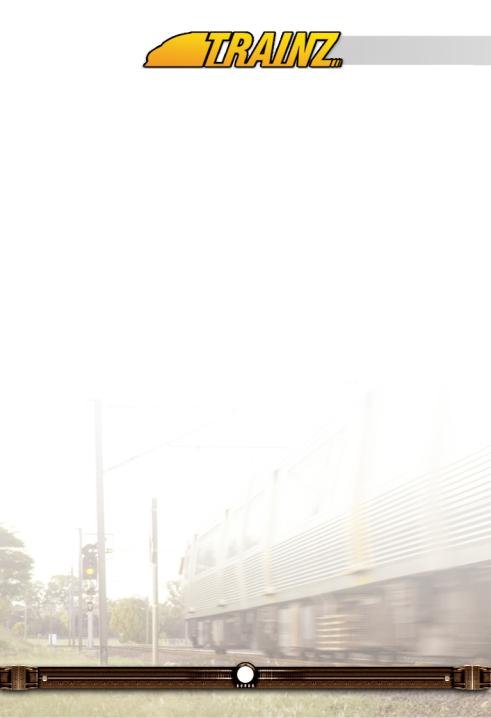
Contents
1 Introduction . . . . . . . . . . . . . . . . . . . . . . . . . . . . . . . . . . . . . . . . . . . . . .3
2 About This Manual . . . . . . . . . . . . . . . . . . . . . . . . . . . . . . . . . . . . . . . .4
3 What’s New in TRS2006? . . . . . . . . . . . . . . . . . . . . . . . . . . . . . . . . . .5
4 Conventions . . . . . . . . . . . . . . . . . . . . . . . . . . . . . . . . . . . . . . . . . . . . .6
5 Installation . . . . . . . . . . . . . . . . . . . . . . . . . . . . . . . . . . . . . . . . . . . . . .8
6 TRS2006 Launcher . . . . . . . . . . . . . . . . . . . . . . . . . . . . . . . . . . . . . .10
7 Configure TRS2006 . . . . . . . . . . . . . . . . . . . . . . . . . . . . . . . . . . . . . .12
8 Launching TRS2006 . . . . . . . . . . . . . . . . . . . . . . . . . . . . . . . . . . . . . .26
9 Driver . . . . . . . . . . . . . . . . . . . . . . . . . . . . . . . . . . . . . . . . . . . . . . . . .27
10 Surveyor . . . . . . . . . . . . . . . . . . . . . . . . . . . . . . . . . . . . . . . . . . . . . . .44
11 Surveyor in Depth . . . . . . . . . . . . . . . . . . . . . . . . . . . . . . . . . . . . . . . .62
12 Engineer’s Guide . . . . . . . . . . . . . . . . . . . . . . . . . . . . . . . . . . . . . . .154
13 Railyard . . . . . . . . . . . . . . . . . . . . . . . . . . . . . . . . . . . . . . . . . . . . . .226
14 Trainz Exchange . . . . . . . . . . . . . . . . . . . . . . . . . . . . . . . . . . . . . . . .231
15 iTrainz Chat & Portal . . . . . . . . . . . . . . . . . . . . . . . . . . . . . . . . . . . .232
16 Content & Assets . . . . . . . . . . . . . . . . . . . . . . . . . . . . . . . . . . . . . . .243
17 Content Manager Plus . . . . . . . . . . . . . . . . . . . . . . . . . . . . . . . . . . .244
18 PaintShed . . . . . . . . . . . . . . . . . . . . . . . . . . . . . . . . . . . . . . . . . . . . .264
19 Content Creator Plus . . . . . . . . . . . . . . . . . . . . . . . . . . . . . . . . . . . .280
1

20 Track IR . . . . . . . . . . . . . . . . . . . . . . . . . . . . . . . . . . . . . . . . . . . . . .298 21 gMax . . . . . . . . . . . . . . . . . . . . . . . . . . . . . . . . . . . . . . . . . . . . . . . . .300 22 Keyboard Controls Summary . . . . . . . . . . . . . . . . . . . . . . . . . . . . . .302 23 Credits . . . . . . . . . . . . . . . . . . . . . . . . . . . . . . . . . . . . . . . . . . . . . . .312 24 Beta Testers . . . . . . . . . . . . . . . . . . . . . . . . . . . . . . . . . . . . . . . . . . .313 25 Third Party Group . . . . . . . . . . . . . . . . . . . . . . . . . . . . . . . . . . . . . . .315
1 - Introduction
Welcome to the next generation of Railroad Simulation and the fourth in the current Trainz series.
With this, the 2005 Edition of Trainz Railroad Simulator (TRS2006), we have created an open-ended, interactive, living, breathing world that lets you customize the experience to suit your own personal tastes. Whether you want to drive trains, manage the movements of passengers and goods, control industry outputs or create your very own unique railroad route or layouts, TRS2006 is the platform that helps your dreams come true.
The team at Auran wish to thank you for purchasing this evolutionary product and we trust you will not only enjoy what’s in the box, but that you will also join the rapidly growing online Trainz community to expand and enhance your experience. Here you are able to download new content for free, share your creations and ideas. Discover more about the world of Trainz at www.railroadsimulator.com.
2 |
3 |
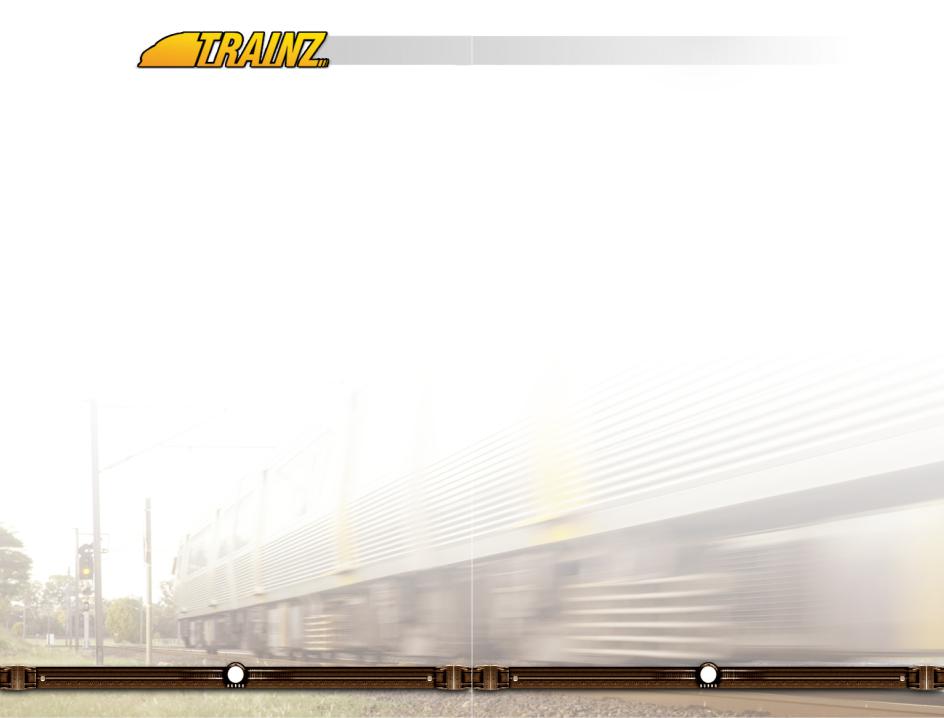
2 - About This Manual
The manual you are reading is designed to show you how to install TRS2006, configure it to suit your PC and then get started with each of the major components.
To gain a deeper understanding of each module and component, and to make the most out of your Trainz experience, there are a number of other Guides included in this manual.
As Trainz is constantly evolving, you should also visit the online community section of the Trainz website to discover more about the latest updates and improvements.
The website also contains additional documentation which provides more information for those users who want to have a go at creating their own custom content.
3 - What’s New In TRS2006?
If you have enjoyed previous versions of the Trainz product, we’d like to bring you up to date with a list of the major new features you will find in TRS2006.
•All new localized content appeals to regional markets.
•Deeper and more complex routes take advantage of the many new features added since the release of TRS2004.
•Cab Control Graphical Interface available when in Cab Control.
•Wheelslip and Coupler breakage enhancements made to the physics engine.
•New Animated Turnouts give trackwork a more realistic appearance.
•iTrainz in game chat allows users to talk to other users while playing.
•Backdrops: a new object type that is rendered regardless of the view distance settings.
•View camera can now be placed within passenger cars.
•New Content Manager Plus makes it easier to access and organise content.
•Improved tutorials help first time users into the game.
•Hint and Tips added to Loading Screens.
•Added functionality on the Mini-map screen; query industry and consist information.
•Re-styled Driver and Session menu screens allow for easier navigation of installed routes and sessions.
•New PaintShed with more flexible interface that is included as part of the installation.
•Over 50 rules, more than double the amount included with TRS2004.
•Bogey and bridge sounds supported.
4 |
5 |

4 - Conventions
Throughout this manual we use abbreviations and terminology that are explained here.
TRS2006 |
Trainz Railroad Simulator 2006 |
CMP |
Content Manager Plus |
CCP |
Content Creator Plus |
DS |
Download Station |
Click LMB |
Click on the left mouse button |
Click RMB |
Click on the right mouse button |
Click LMB+H |
Click on the left mouse button and hold it down |
Click RMB+H |
Click on the right mouse button and hold it down |
Zoom |
Zooming in or out using the mouse wheel or |
Compass |
PageUp/PageDown keys |
The three-dimensional compass cursor in Surveyor. |
|
Red Lights |
Red LED-like buttons |
Green Lights |
Green LED-like buttons |
KUID/KUID2 |
Unique identifier for an object |
Turnout |
To simplify things this refers to a point or a |
|
junction, so as not to confuse it with a switch lever, |
Switch |
which is used to control a turnout. |
Lever used to control a turnout |
|
Driver |
An artificial intelligence (AI) avatar that can be given |
|
commands in a Driver session (also the name of |
Consist |
the driving simulation module). |
Any mixture of rolling stock and/or locomotives |
|
Loco |
Short term for Locomotive. Normally refers to the |
Vehicle |
powered unit of any consist. |
Refers to a piece of railroad rolling stock. Can be a |
|
Route |
loco, passenger car or freight wagon. |
A map defining world objects, (rails, industries, |
|
Session |
scenery, etc.) textures and terrain. |
A Driver session associated with a Route capable of |
|
|
being run as a self-contained activity. |
Product |
Any commodity produced or required by industries |
Passengers |
that can be transported by a capable vehicle. |
A special type of Product associated with passenger |
|
Railroad |
stations and passenger cars. |
Equivalent to the term "railway" in Australia and |
|
Bogey |
Britain. |
British/Australian term for a truck (wheelset) on a |
|
Industry |
piece of rolling stock. |
Interactive scenery component placed on a route. |
|
BR |
British Rail |
QR |
Queensland Rail |
SAR |
South Australian Railways |
Tip: Train terminology varies greatly throughout the world (even between English speaking nations), so please take note of any unfamiliar terms in this section.
6 |
7 |
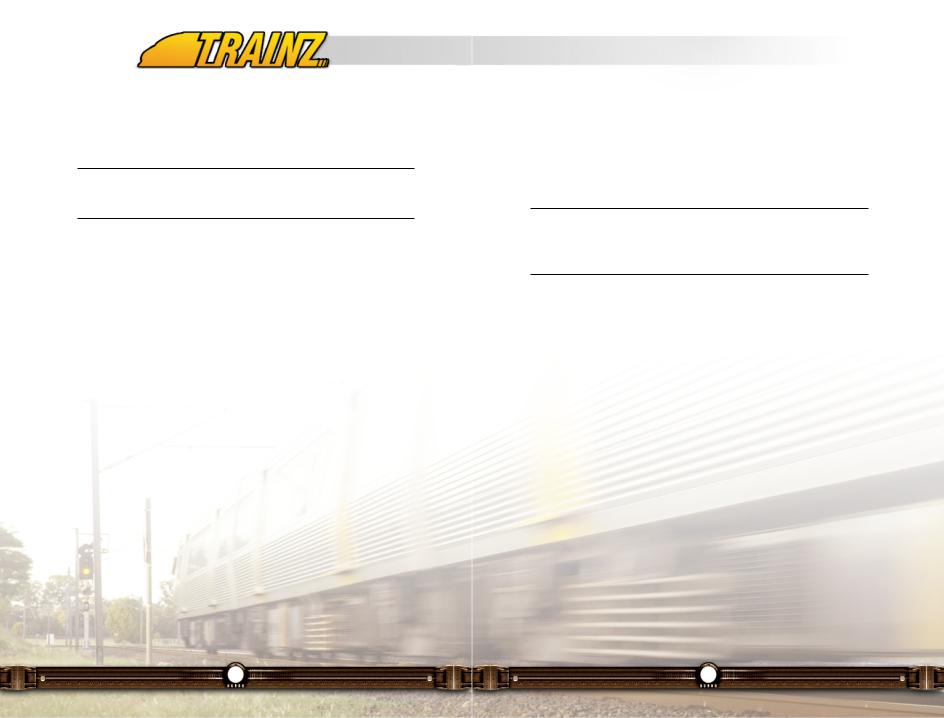
5 - Installation
Before installing, ensure that you have sufficient disk space (of at least 4GB) and that you have no other programs running.
WARNING: Please turn off any virus scanning programs for the installation! Don’t forget to turn your virus scanner back on once the installation is over.
Begin the installation process by inserting the TRS2006 DVD Disk or CD Disk 1 into your CD/DVD drive.
CD Users
Begin the process by inserting disc #1 into your CDROM drive. If you have auto play enabled you will be presented with the install shield program that will guide you through the installation process. If the install shield does not appear try double clicking on your CDROM drive through My Computer or manually browse the contents of the CD and double click on the SETUP.EXE file found in the root directory of the CD to start the installation process.
DVD Users
Begin the process by inserting the DVD into your computers DVD drive. If you have auto run enabled on your computer you will be presented with the Trainz2006 DVD menu. If you don't have auto run enabled and no menu appears try double clicking on your DVD drive through My Computer or manually browse the contents of the DVD and double click on the AUTORUN.EXE file found on the root directory of the DVD.
Once you are presented with the DVD menu you can choose to either install TRS2006 or view the bonus movie that has been included.
When you choose to install TRS2006 the DVD menu will close and the Install Shield will now begin to guide you through the installation process.
Install Shield
The Install Shield will now guide you through the steps of the installation process. When prompted, enter your CD Key in upper case.
For further help in installing TRS2006, please refer to the Readme file found in the install directory of Trainz or on the TRS2006 Disk.
Tip: Once you have installed TRS2006, be sure to register with Planet Auran to get all the benefits that come with being a registered user such as new content and the forums. See section 7.1 for further details.
8 |
9 |
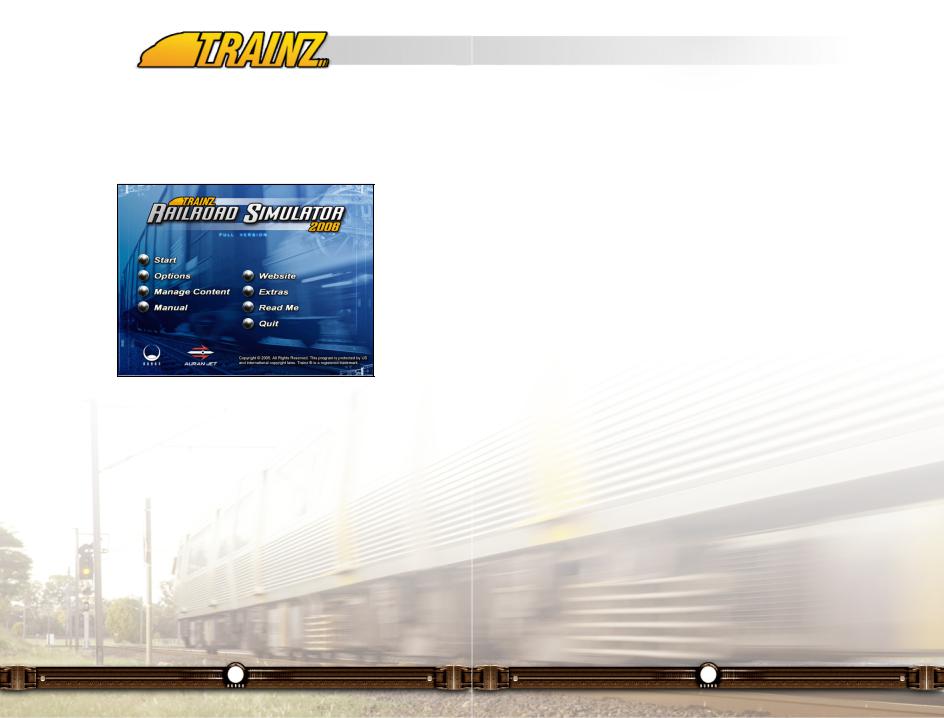
6 - TRS2006 Launcher
Once you have successfully installed TRS2006, Double Click on the TRS2006 icon on your Desktop (or at Auran > on the Start menu) to access the Trainz Launcher menu.
The Trainz Launcher menu has a number of items:
Start
This will launch Trainz.
Options
Enables you to customize your settings for Trainz, including your Planet Auran settings, display settings and advanced graphics features such as shadows. Chapter 7 of this manual examines these settings in detail.
Manage Content
This will start Content Manager Plus, a utility to help you manage your Trainz content and to download additional content. Chapter 17 of this document examines the CMP utility.
Manual
Opens up the .PDF version of the Trainz manual (i.e. what you are reading now). The Adobe® Reader® application must be installed for you to view this manual.
Website
This will open up your browser to the TRS2006 community website where tens of thousands of Trainz fans are ready to help you with your questions and share experiences.
Extras
A number of extra documents from Auran and the 3rd Party Content Creators.
Read Me
Opens the readme text file which details last minute information about this release of Trainz.
Quit
Closes the TRS2006 Launcher menu.
We strongly suggest that you check out these other menu items and familiarize yourself with the Options, Read Me and Trainz Website.
10 |
11 |

7 - Configure TRS2006
This is where you can customize various options to maximize your enjoyment of Trainz Railroad Simulator 2006.
7.1Planet Auran
Planet Auran is the rapidly growing online community that is free for all TRS2006 users to join.
Why join? Because there is an incredible wealth of additional information and content available that will enormously expand your enjoyment of TRS2006. Highlights include:
•Additional files and utilities that help you get the most out of TRS2006;
•Online forums (message boards) where you can ask questions you have about using TRS2006 and learn from others; and
•Interactive online features like iTrainz Chat and iPortal.
If you have not already joined, click on the "Sign up for a new account" button to register. This will launch your default browser with the Planet Auran registration page that will guide you through the registration process. You will need to have an Internet access and be online to do this.
Once you’ve registered, by using Content Manager Plus you’ll have access to over 40,000 different items such as routes, engines, rolling stock, buildings, bridges, track, etc so that you can build exactly the rail empire you want to.
Once you have joined Planet Auran, you can enter your Username and Password and check the "Always Online" box.
12 |
13 |
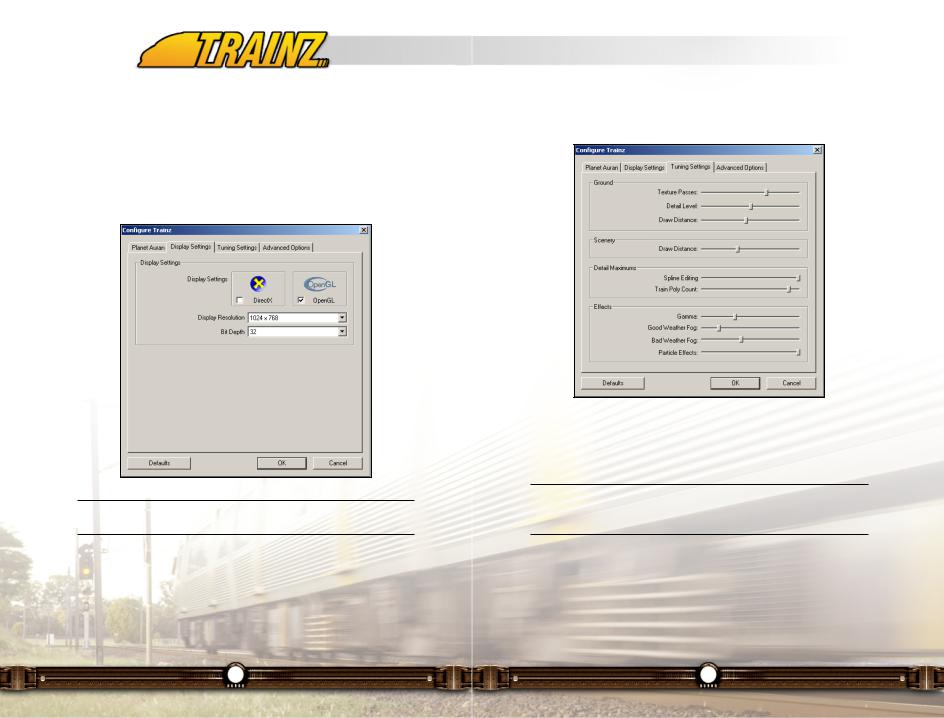
7.2Display Settings
Next, click on the Display Settings menu tab. DirectX mode or OpenGL mode can be used depending on your graphics hardware requirements. For older systems, DirectX generally improves rendering speed. Experiment to see which graphics setting works best with your hardware. Display Resolution determines what resolution your screen will run at. Bit Depth should be left at 32 bit unless your graphics card doesn’t support 32 bit graphics.
Note: Ensure that your latest graphics drivers are installed for maximum performance.
7.3Tuning Settings
This is where you can configure TRS2006 to create a balance between your hardware and your graphical performance and frame rate. Each of the sliders affects the way the graphics are handled in Trainz and only the latest systems will allow you to run with "full sliders" (moved to the right) and maintain satisfactory frame rates. Even then, by adding more objects or trains to a
scene, it is possible to make the latest hardware struggle. Quite simply, the better your hardware, the better the performance.
To balance scene density and frame rate, your challenge is to decide whether to decrease the sliders, thereby lowering the quality or upgrade your hardware to improve performance.
Note: These settings are also accessible in the Driver and Surveyor modules under the main menu. See sections 9.14 and 11.13.8 for further details.
Ground - Texture Passes
Determines the number of ground textures per area. Set Texture Passes to the first notch (0) and you will see square textures. Moving the setting to '1' and you will notice one set of textures blend into the next one. Some graphics cards handle multiple textures better than others.
14 |
15 |
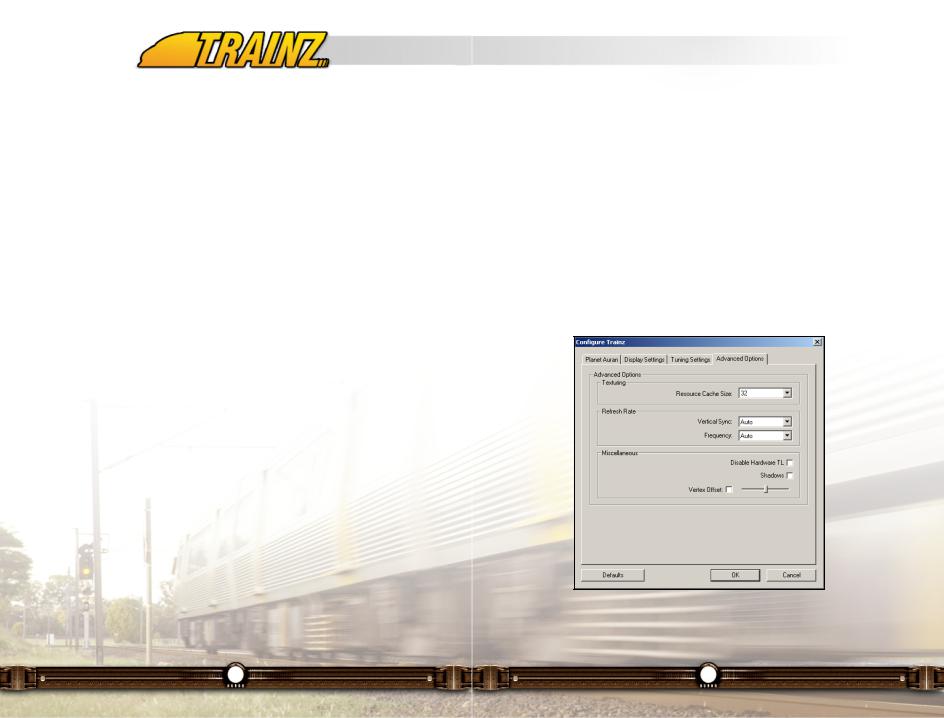
Ground - Detail Level
Defines the degree of definition in the terrain. The lower the settings, the lower the number of ground polygons drawn.
Ground - Draw Distance
Defines the maximum viewable distance of the ground. A higher setting will stop the ground "popping" into view, but requires a more powerful video card.
Scenery - Draw Distance
Determines the maximum viewable distance of the scenery objects. Generally you should set this at a similar scale to the ground draw distance.
Detail Maximums - Trains Poly Count
Determines how many polygons will be allocated to the locos and wagons on screen. The number of cars displayed at one time also affects this rate, so a low setting with lots of cars will result in some deformation of the models.
Detail Maximums - Spline Editing
Can be set at 3 levels. At the simple setting, the splines are drawn in "white line" form until you have finished laying the last spline point. At the detailed level, the splines are updated dynamically as you are laying them.
Effects - Gamma
Sets the brightness of the screen while in TRS2006. If you are finding the screen too dark move the Gamma slider to the right, if it's too bright move the Gamma slider to the left.
Effects - Good Weather Fog
Adjusts the distance the "fog" is drawn. The lower the setting, the less fog is drawn. Fog itself, however, doesn't place a high load on your system. Rather, it is used to disguise the visual artifacts that can occur in the distance if your sliders are set low. Therefore, it is recommended that if you have your general performance sliders set low, you should increase the fog slider to hide the visual "clipping".
Effects - Bad Weather Fog
Works in the same manner, but is only drawn when it is raining or snowing.
Effects - Particle Effects
Level of effects such as smoke from a locomotive or factory chimney. The lower the setting, the less smoke etc. you will see, but your graphics performance will increase.
7.4Advanced Options
These options let you tweak some of the other hardware related systems to improve performance even more. The main bottleneck on current graphics cards is the Shadows option. Turning this option off will generally improve your performance dramatically. For a full explanation of the other options, please read the Readme found on the Trainz Launcher.
16 |
17 |
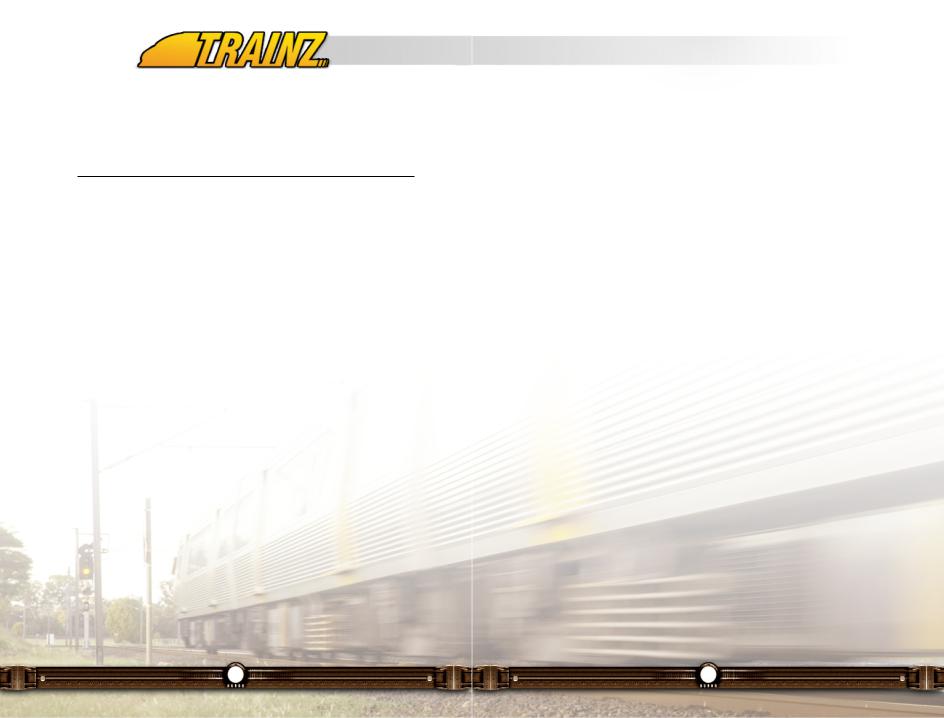
7.5Configuration File Settings
You can also tweak performance of TRS2006 to suit your PC hardware by using a text editor like Notepad to edit the "trainzoptions.txt" file. You will find the "trainzoptions.txt" file in the directory into which you've installed TRS2006.
WARNING: Please be aware that these command line parameters are to be used at your risk. If you experience any problems with your copy of TRS2006, including crashing or visual problems, return your "trainzoptions.txt" to its original state (see Section 9.4) before contacting the Auran helpdesk. Auran will not be able to provide support on issues that relate to the use of these options. Before you start playing with the "trainzoptions.txt" file why not make a backup of the default "trainzoptions.txt" file by saving the file with a different filename, say "trainzoptions.BAK".
7.5.1Command Line Parameters
-DepthBits = XXX
Select the number of bits used for the z-buffer (depth buffer.) Available choices are generally 16, 24, or 32. Some video card drivers incorrectly interpret '32' as '16', so '24' may give better results on these cards. When a stencil buffer is used, the depth bits may need to be adjusted down according to the size of StencilBits; ie. 24 depth + 8 stencil = 32 total. It is possible that this option can be overridden by the settings for the video card driver.
-StencilBits=XXX
Selects the number of bits used for the stencil buffer. Usually 0, or 8. A stencil buffer is required for Trainz to render shadows. Some cards do not support stencil buffers, or do not support stencil buffers in certain resolutions / modes. Where a card does not support a Stencil Buffer, the driver will sometimes attempt to use a Software stencil buffer, which is very slow. Generally a 24 or 32 bit DepthBits is required in order to enable the Stencil Buffer.
-disablestencil
Overrides the StencilBits selection and forces it to zero.
-ColorBits=XXX
Selects the number of bits used for the color buffer. Usually 16, 24, or 32. Larger numbers result in better color accuracy and less dithering. Some cards may require ColorBits = (DepthBits + StencilBits)
-Jet=XXX
Provide the path to the Jet folder. In the release version of Trainz, this is the path from the Trainz directory to the bin directory, ie. "bin". For internal builds, this usually points at the "Jet" directory, not "Jet/Bin". This option is required, if it is set incorrectly Trainz will crash at load time.
-ResourceMemory=XXX
Specifies the amount of memory reserved (in megabytes) for resource disk caching. This will prevent Trainz from accessing the disk as often, reducing caching time and 'stutter' caused by slow disk access. This option defaults to 0.
-vsync
Activates 'vertical sync'. This option may be overridden by the video card driver settings. When active, vertical sync results in smoother updates (no visual tearing) but lower frame rates. This is usually a good thing. This is equivalent to "-vsync = 1".
-vsync=XXX
See "-vsync" for more info. Allows finer control over vsync, attempting to synch to every second frame ("-vsync=2") or every third frame ("-vsync=3") etc. Larger numbers lower the maximum possible frame rate further but may improve the chance of achieving a steady frame rate. Probably not useful for most people.
18 |
19 |

-frequency=XXX
Attempt to force the refresh rate of the display to the specified frequency (in Hz.) If the video card does not support the specified frequency at the specified resolution, this may cause Trainz to exit on load with a "check your settings" message. Some common frequencies are: 60, 70, 72, 75, 85. Higher numbers provide visually better results as long as the display properly supports the requested frequency. Selecting a frequency which is supported by the video card but too high for the display is untested and could cause the display to become garbled.
-width=XXX
Manually specify the window/screen width (in pixels). When in fullscreen mode, this must match one of the available display resolutions, and an appropriate height must be selected. When in dualhead or surround modes this is the horizontal resolution across all displays, not across a single display.
-height=XXX
Manually specify the window/screen height (in pixels). When in fullscreen mode, this must match the Width setting used. Width-to-Height ratios other than 4:3 are untested. When in dualhead or surround modes, this is still the vertical height of a single display.
-640
Equivalent to specifying "-width=640" and "-height=480".
-800
Equivalent to specifying "-width=800" and "-height=600".
-1024
Equivalent to specifying "-width=1024" and "-height=768".
-znear=XXX
Override the default z-buffer near distance. Specified in meters. The default is 0.1 meters. Smaller numbers allow the viewing of objects closer than 10cm but rapidly decrease the z-buffer accuracy and will cause visual artifacts on most
graphics cards. Larger numbers will improve the z-buffer accuracy and may provide less artefacts, especially in 16-bit depth buffer modes, however there may be problems viewing nearby objects such as inside cabin view.
-zfar=XXX
Override the default z-buffer far distance. Specified in meters. The default is 1500m. Decreasing the far distance will result in slightly improved z-buffer accuracy but will result in far-away objects not being visible (Note: this may not result in a speed gain if a high draw distance is specified in the Trainz tuning screens as Trainz will still consider the far-away objects as visible even if the video card is unable to render them.) Increasing the z-buffer distance probably isn't useful as Trainz doesn't allow the selection of draw distances greater than about 1300m, and the z-buffer accuracy will be decreased causing visual artefacts.
-disablefog
Causes fog to be completely disabled.
-fullscreen
Causes Trainz to take over the chosen display. This is the preferred mode.
-windowed
Causes Trainz to run in a window. This is useful for debugging, however may result in reduced frame rate and cause visual 'stutters', especially in DirectX mode.
-dualhead
Enables support for dual-display mode. This will only work if you have two displays attached to a single video card acting as a single, large display (i.e. single frame-buffer). This wont work if there are two displays on different video cards or configured to act as independent displays. Currently dualhead support is only utilized in the Driver module. This option requires that a dualhead resolution is selected (ie. 8:3 ratio) and that Trainz is run in fullscreen mode. On some video cards this option may require you to switch to the appropriate resolution prior to launching Trainz.
20 |
21 |
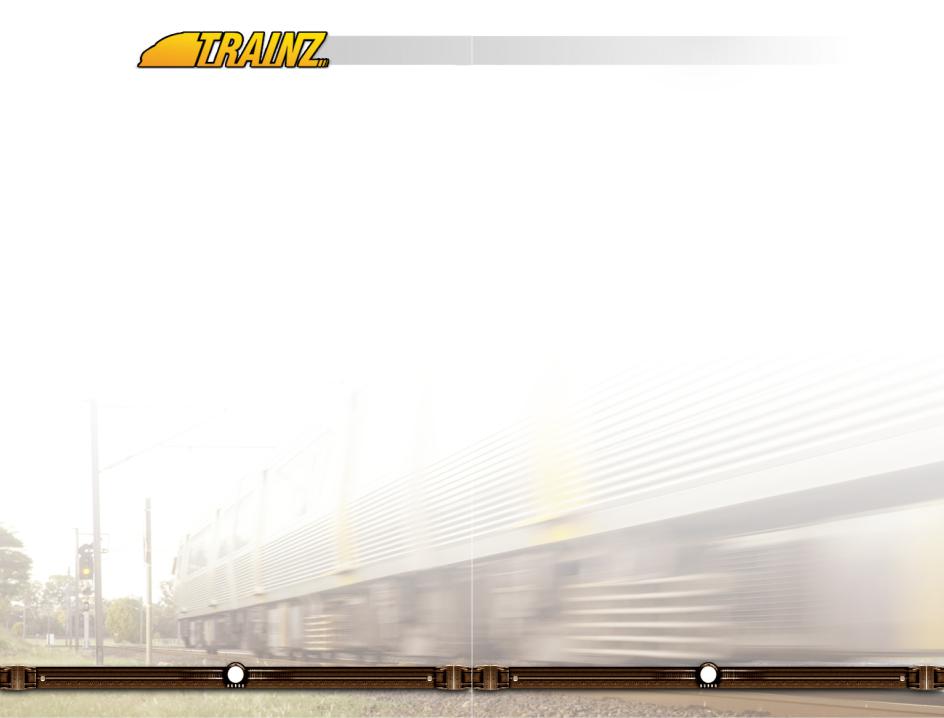
-surround
Enables support for triple-display (triple-head / surround gaming) mode. This will only work if you have three displays attached to a single video card acting as a single, large display (ie. single frame-buffer.) This wont work if there are three displays on different video cards or configured to act as independent displays. Currently surround gaming support is only utilised in the Driver module. This option requires that a surround gaming resolution is selected (ie. 12:3 ratio) and that Trainz is run in fullscreen mode. On some video cards this option may require you to switch to the appropriate resolution prior to launching Trainz.
-disablecarz=X
Default 0 (carz enabled). If set to 1 (carz disabled), then carz will not appear on roads. This may (untested) result in smoother framerates. Experimental only.
-framestoaverage=XXX
This option controls the 'smoothing' of frame rate timing. Increasing this option may result in less visual 'stutter', however can cause period 'surges' if rapid changes in frame rate occur. Increasing this option may be useful for high-end machines with fast graphics cards where the frame rate remains fairly constant. Default is 4, maximum is currently 16, minimum is 1 (no averaging.)
-heartbeat=XXX
Specify the time interval at which the physics heartbeat occurs (in seconds). Defaults to 0.03sec. Larger intervals decrease processor usage for physics at the expense of accuracy. Intervals larger than 0.05sec are not recommended. Changing this option is probably unnecessary and may have a negative impact on physics accuracy.
-filter=XXX
Specify the texture filtering mode. Default is trilinear which provides the best visual results. Other options are bilinear and none. This option is unlikely to provide performance gains, except perhaps on minimum-spec (or lower) graphics cards.
-intro=XXX
Changes the playing mode of the Trainz loading movies. Available options are "disable" and "fullscreen". Fullscreen causes the movies to be played in fullscreen mode instead of centered on the screen. Disable skips the intro movies.
-quit
Causes Trainz to quit after the loading sequence has completed. Used for diagnostic purposes only.
-DisableEnvMap
Causes Trainz to not render Environmental maps. This may improve performance on certain minimum-spec (or lower) graphics cards.
-framerate=XXX
Requests that Trainz limit the frame rate to the specified number of fps. Not tested. Doesn't appear to work with vsync enabled. May help with maintaining a stable frame rate on faster machines.
-render=renderdirectx
Cause Trainz to use the Direct3D API for graphics rendering as opposed to OpenGL (default). This may improve performance or compatibility where the video card drivers do not correctly support OpenGL.
-autopilotsignaldistance = XXX
Modifies the autopilot signal-visibility distance, specified in meters. Default value is 200m. Smaller values are not permitted. This will affect how the autopilot reacts to the signals - how soon it will begin to slow down and how close to the signal it will attempt to stop.
-disableztest
Turns off z-buffer testing for coronas (signal flares, headlights, sun.) This will make the flares shine *through* other objects, however will reduce artefacts with the ground and train clipping the flare.
22 |
23 |
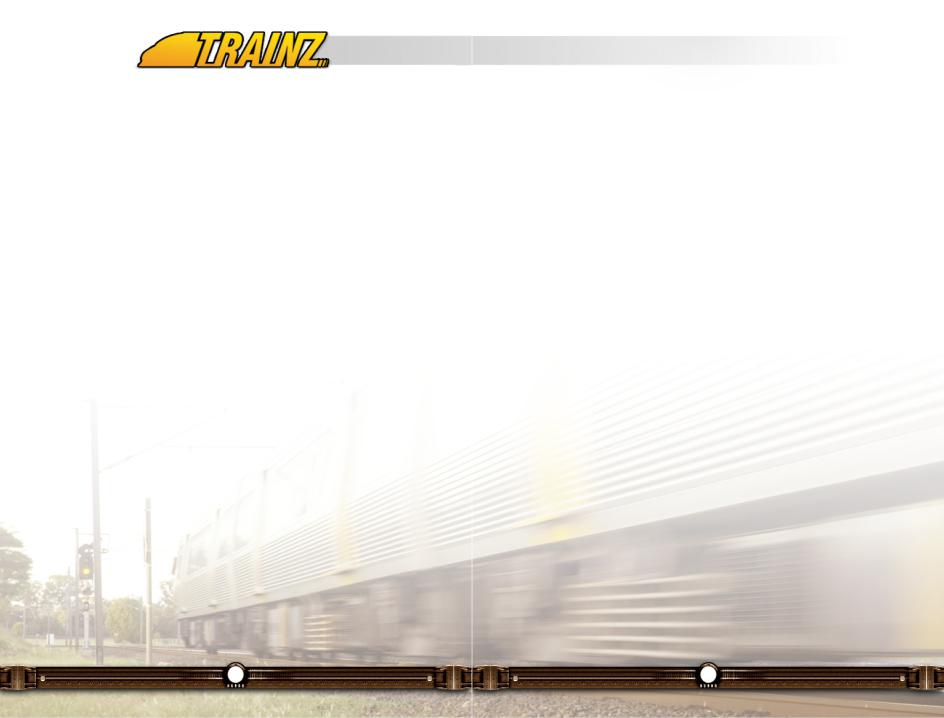
-showcachebar
This option enables the display of the cache bar. The cache bar is the horizontal red bar that appears in the bottom left corner of the screen when assets are being loaded such as when you open a route up or a moving around in a large route. Unlike previous versions of Trainz, TRS2006 does not have the cache bar displayed by default.
-debug
Including this option enables debug mode. The main feature of debug mode is that it allows you to accelerate the game speed by holding down the Shift key. This can be useful for content creators that might want to test their sessions more quickly. However debug mode is not a supported feature and the behavior of Trainz in not guaranteed when using the Shift speed-up.
-allownoctrlrightclick
Disables the requirement of having to hold the Ctrl key when using RMB top open the menu of a vehicle or industry in Driver. Previous versions of Trainz did not require the Ctrl key to use RMB to access the menu and this option allows for those who prefer the older way.
7.5.2Defaults
If you have been tweaking the "trainzoptions.txt" file and caused your TRS2006 install to become unstable you can either copy in the backup file we asked you to create in Section 9.2 or you can return it to the default "trainzoptions.txt" file by making it read as follows:
-DepthBits=24 -StencilBits=8 -fullscreen -Jet=bin -cabinfov=65 -driverfov=55
-DefaultAutoMip=none
7.6Troubleshooting
If you get any error messages or have problems while running Trainz, please read the Readme found on the Trainz Launcher for general information on how to solve these issues. Make sure that you have the latest video card drivers installed and that you have installed DirectX 9 or above.
You can also visit the website and go to the Technical Support section for the latest fixes and solutions. Another excellent source of information is the Trainz forums where users just like you offer tips and tricks for almost any aspect of using Trainz or getting the most out of your experience.
24 |
25 |
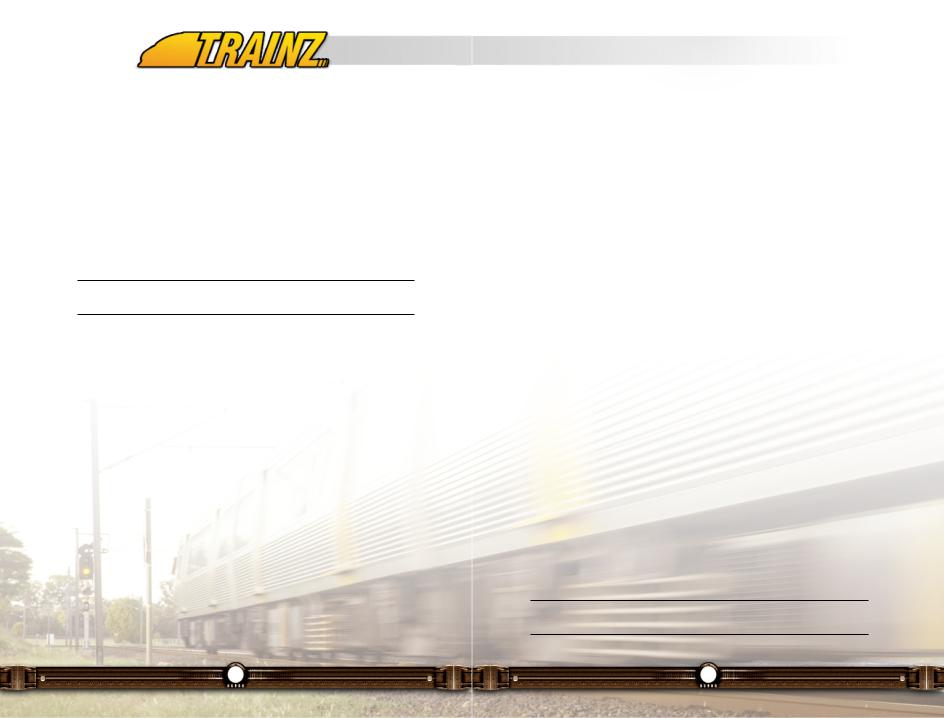
8 - Launching TRS2006
Use your mouse to highlight the menu options in the Trainz Launcher then use the LMB on the "Launch Trainz" menu option and you will see the loading gear rotating whilst Trainz takes a few moments to load.
In the Trainz Main Menu, there are 3 game modules to choose from: Surveyor, Driver and Railyard, as well as the Trainz Exchange option.
The following sections of this TRS2006 Manual give you a basic understanding into each of these areas.
Note: To find out more about the Driver module, read Chapter 9. Surveyor is covered in Chapters 10 and 11.
9 - Driver
9.1Introduction
The Driver Module provides a lot more than just a train driving simulation. TRS2006 provides you with a number of different ways of controlling the trains on your railroad.
Firstly you can hop into the cab and explore the tracks from behind the throttle. You can choose either the simple DCC speed control system or the realistic Cab controls using each of the levers and switches in the cab. You can watch the trains from trackside as they come thundering past, or from a bird’s eye view tracking along with the train.
You can even switch to a Map View and control all the junctions, monitor signals and control traffic flows from a 2D perspective.
While running multiple consists, you can choose to control each train yourself, or let the computer AI system control the trains as you control the switches.
Finally, you can even issue specific orders to Drivers that you allocate to each train.
In addition to the various systems of control, there is also a fully interactive industry model that automatically generates waybills for goods that need to be delivered to the various industrial sites. Your task under this mode is to maintain the operation of these industries by controlling movement of goods and resources along your railroad. You can watch as your train or the trains under the control of your drivers are each loaded and unloaded at the various industries. For more information about configuring an industry, see section 10.4.4 of this manual.
Note: This chapter is only an introduction to Driver. More detailed instructions can be found in Chapter 12 - Engineer’s Guide.
26 |
27 |

9.2Starting your Railroad Career
Once you have launched TRS2006, start Driver by Clicking LMB on the Driver menu option.
Once Driver loads you will see a list of available Routes with the number of sessions available for each route shown in the brackets next to it. Click on a route, then select a session.
When you click on a Session, check the text information contained in the Description window that appears in the top left of the screen. Note how the "Load” button appears at the bottom right of the screen when a session has been selected.
9.2.1Tutorial Sessions
TRS2006 includes 6 introductory tutorial sessions to help you get started with using Driver. The 6 tutorials listed in order are:
• |
Tutorial 1 |
- Controls |
(British Midlands 2) |
• |
Tutorial 2 |
- Waybills |
(British Midlands 2) |
• Tutorial 3 |
- Diesel Cab |
(City and Country USA 2) |
|
• |
Tutorial 4 |
- Steam |
(Outback Australia 2) |
• |
Tutorial 5 |
- Drivers |
(Highland Valley Industries) |
• Tutorial 6 |
- Commodities |
(City and Country USA 2) |
|
Note: The tutorial sessions take place on several different routes and won’t appear in order on the Driver Main Menu. To get to a tutorial, find its corresponding route in the above list and expand that route in the Driver Main Menu.
To get started Click LMB on the "British Midlands 2" route. Then select "Tutorial 1 - Controls". Once the session has been selected, Click LMB on the load button found in the bottom right corner of the screen.
|
|
28 |
29 |

Trainz will now start running Tutorial 1 where you will be guided through all the basic controls that make up the TRS2006 Driver interface. Once you have gone through Tutorial 1, go through the other tutorials and see what else there is to do.
9.3Camera Controls – Controlling Your View
There are many different views of the 3D world in TRS2006 as well as a Map View that gives you a 2D top down view. You can zoom in or out, pan around and change the camera focus point with each of these views.
Shown here is the Camera HUD Panel. The different camera view icons and their shortcut keys are listed as follows. Try to explore the Trainz world with them.
9.3.1Cab View
Firstly, make sure the view is focused on a locomotive (Click LMB on a loco to focus the view) then Click LMB on the Cab View button (or use the "1" key). Your view is now from in the driver’s seat of the
cab. Use RMB+H to look around the cab and out of the different windows. You can also change your viewpoint in the cab by pressing the "[" and "]" keys. If the locomotive is a dual cab unit you can press the "Alt+C" key to switch between the cabs.
9.3.2External View
When you first start Driver you will generally be in the External View with the scene focused on a particular locomotive. Use RMB+H and move the mouse around to rotate and elevate the view (you can
also use the cursor keys), with the locomotive at the center of the screen at all times. Want to get closer? You can use your mouse wheel to zoom in and out, or use the Page Up/Page Down keys on your keyboard.
If you Click LMB on one of the cars attached to the train, the view changes so
that the selected car now becomes the focus of the view. You can also press the "-" and "+" keys on the main keyboard to select the next or previous car in the consist. You can even Click LMB on other trains to shift the focus to the selected train or click on the consist icons in the 2D Map View as well.
9.3.3Tracking Views
Now Click LMB on the Tracking View icon and your view changes to the nearest Tracking camera. There are two types of cameras; Static and Tracking, and these are placed in the 3D world in
Surveyor mode. Static cameras will stay fixed in direction and allow the tracked object to move out of the frame. Tracking cameras are fixed in place, but pan with the tracked object, keeping it in the center of the view. If there are no Tracking/Fixed Cameras within visual range of the tracked object, the view reverts back to the external view until a Tracking Camera comes within range.
9.3.4Free Roaming View
The Free Roaming view is extremely flexible and operates in a similar fashion to navigating in Surveyor. To move the camera focus point, simply Click RMB in the 3D world to where you want the new
central focus point to be. The view smoothly moves to the new focus point. Now you can use the cursor keys to rotate or change elevation and the mouse wheel or Page Up/Page Down keys allow you zoom in and out. By holding down RMB and moving the mouse you can continuously change the focus point and hence the view. By combining this mouse movement with the cursor keys and the zoom function it lets you roam around the scenery at your will.
9.3.5Map View
The icon for the Map View is at the bottom right of the screen or you can use the Ctrl-M shortcut key. You will find the Map View is useful to get an overview of where your trains are in relation to the
industries, the track configuration, plotting your train movements, and checking turnout settings and signal states.
On the 2D Map View you will see the position, length and name of each Consist, the direction set for each turnout and important names for assets
30 |
31 |
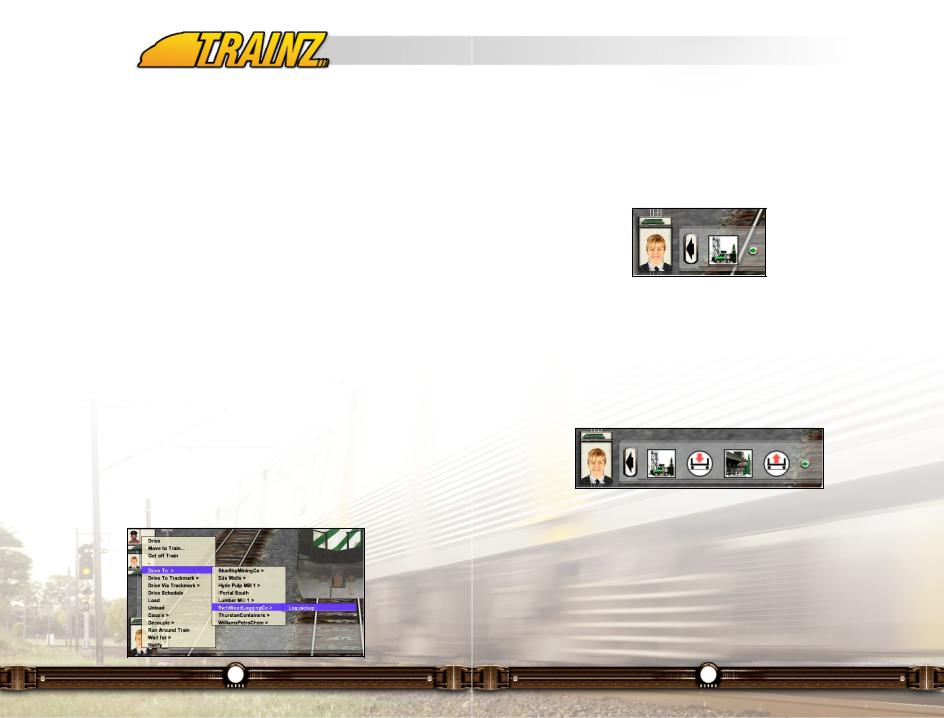
such as turnouts, industries and stations. Zoom in and out using the "Page Up" or "Page Down" keys (or your mouse-wheel) to see more or less of the route.
The map follows the movement of the currently selected Consist. The currently selected Consist shows as green and all other Consists show as gray on the map. Click LMB on one of the gray Consists to center the map view on that Consist.
Click RMB on a point in the map to center the map view to a new location, losing focus on any particular Consist.
You can also set the turnouts by clicking on them and seeing the direction arrows change. Also visible are the state of any signals on the Route.
Exit the map screen by Clicking LMB again on the Map Screen button, or press Ctrl-M.
9.4Driver Commands – Who Goes Where
Open the "FreeformiPortal" session on the "Tidewater North" route. Click LMB on the Driver picture in the lower left of the screen and a list of allocated Drivers appear along the left side of the screen. Click LMB on the Driver "Ami" who should be at the bottom of the list. The camera focuses on the loco of the selected Driver.
We will get this driver to pick up the logs from the Logging Co. and take it to the Lumber Mill.
Click RMB on the driver's picture to bring up the Driver Command menu. Select Drive To > RichWood Logging Co. > Log pickup from the subsequent pop out menus. Note that an icon representing the logging yard appears at the bottom of the screen next to the driver picture. The Driver will immediately begin to carry out his duties, and you can queue up additional orders whilst he is driving.
Click RMB on the driver’s picture and select Load from the Driver Command menu. The Load icon appears to the right of the logging yard icon. Continue on with the sequence and selecting Drive To > Lumber Mill 1 > Logs Drop off and then the Unload command.
You should now have a group of four “Command” icons across the bottom of the screen that represent the commands you have given to this Driver.
Your Driver will continue with his duties in the order that they appear along the bottom of the screen, taking into account speed restrictions and other rail traffic. Each time a task is completed, the Command icon disappears and the Driver commences his next task.
Not only can you issue orders to several Drivers at once (up to 7), you can also give Drivers orders to accomplish tasks based on the Waybill list of industry requirements at the same time. Once your orders are allocated, watch as your railroad comes to life around you.
32 |
33 |
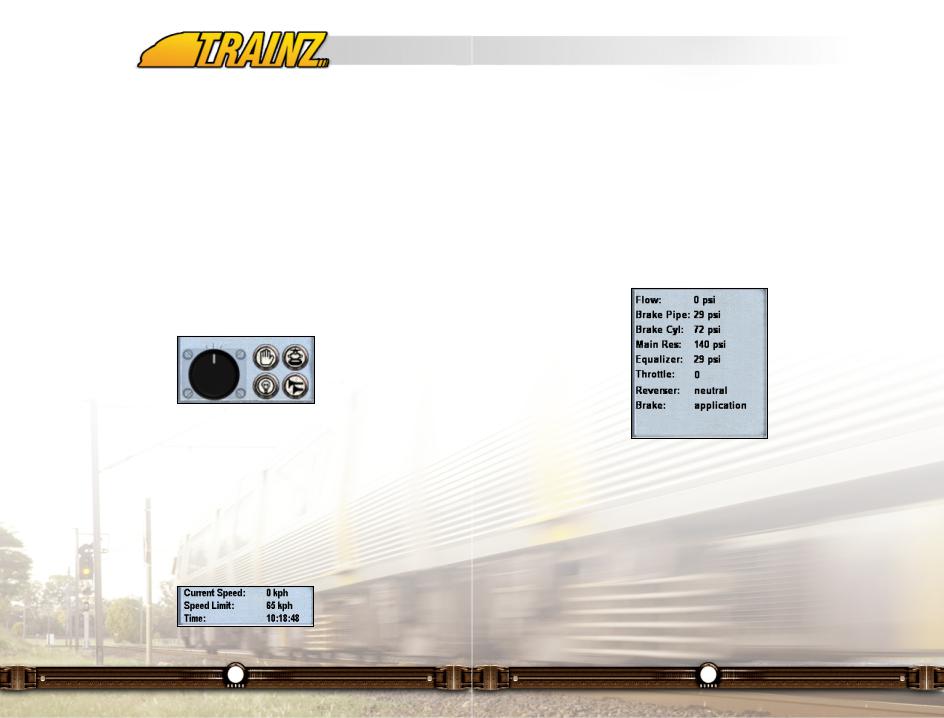
When you need to exit, move the mouse to the top left of the screen, a menu scrolls down and you Click LMB on the Exit button (X) or hit the Esc key. A pop-up window asks if you want to save this session – very handy if the real world interrupts your Railroad Operations.
9.5Drive that Train – You Take Control
There are times when you will want to get into the cab of your very own locomotive and take charge. When any one of your Drivers has no current commands, the Driver HUD appears on the right hand side of the screen. If you are in DCC mode, you will see a speed dial. This is a simplified control system not unlike the DCC (Digital Command Control) systems used on model railroads. Using the dial you can control the speed of your loco and get a feel for driving without having to worry about monitoring brake pressures or knowing which lever to pull and when.
Click LMB+H on the speed dial and drag to change speed. Click LMB on the Stop icon to stop the train. There are momentum effects built into this control system, so don’t expect the train to stop and start immediately. Alternatively use the "W" and "X" keys to accelerate and decelerate respectively. Use the "S" key to get to idle state and the "A" key to apply the handbrake.
The current speed and the track speed limits are shown at the top right of the screen in the Time and Display HUD Panel. Make sure you obey all signals and speed restrictions along the way.
9.6Driving in Diesel/Electric Cab Mode – Are you ready?
Cab Mode provides a more realistic driving experience taking into account factors such as the different power levels at each throttle notch, or the length of the train when applying the brakes. Each of the levers, switches and dials in the 3D cab can be used to operate the locos or you can use the Hotkeys or Cab Control HUD to carry out the same function. (This lets you control the locos from outside, even in Cab Mode).
The following tips will get you started, but we recommend that you check out Chapter 12 - Engineer’s Guide of this manual more detailed information about driving using Cab controls.
Launch Driver and select "Tutorial 3 - Diesel Cab" from the expanded list of the "City and Country USA 2" route. Click LMB on the "Load" button at the bottom right of the screen to launch the Driver Session. Follow through the tutorial’s instructions to learn how to drive a locomotive in cab mode.
To start a locomotive in cabin mode, release the train brakes ("Q"). If the brake cylinder has not emptied you may need to also release the independent brake ("D"). Put the reverser into forward pressing "F". Increase the throttle ("W") slowly and the train will begin to move forward. Use "X" to decrease the throttle and "S" to set the throttle to idle. Use "A" to apply the brakes, and "Z" to lap the brakes. Watch the information in the Cabin HUD Panel to get information on speed, throttle, brake settings and Reverser direction.
34 |
35 |

Note: You cannot engage the Reverser unless the throttle is at idle.
See Chapter 12 - Engineer’s Guide of this manual for more detailed information about driving a locomotive in cabin mode.
9.7 Driving a Steam Engine – Are you up to the challenge?
Entering the cab of a steam locomotive for the first time during a new session, you will find that the light-up crew will have prepared you a nice hot fire. Fire temperature can be gauged by looking at the color; an orange fire is relatively cool, and a white-hot fire is required to raise the necessary pressure to power the locomotive. You should have a nice head of steam already raised and you can check the gauge pressure either in the cab or on the Cabin HUD Panel (pictured below).
Launch Driver and select "Tutorial 4 - Steam" from the expanded list of the "Outback Australia 1" route. Click LMB on the "Load" button at the bottom right of the screen to launch the Driver Session. Follow through the tutorial’s instructions to learn the basics of a driving a steam locomotive in cabin mode.
Opening the firebox doors to increase the airflow and add more coal to the fire by pressing the spacebar. The doors MUST be open to shovel coal. Care should be taken not to add excessive coal, as this will lower the temperature of the fire for a time. As the fire heats up, the boiler pressure should start to rise. Always ensure there is sufficient water in the boiler by checking the water
gauges; they should show be half to two-thirds in the glass. Water level in the boiler is increased by use of the injectors.
Once full pressure has been attained and the brakes released ("Q" and "D"), you can move the locomotive by opening the regulator. The "cutoff" is the percentage of the piston's travel that steam is applied to it and is affected by use of the reversing gear. Full stroke length is 75% and is used for starting the train. As the train begins to gather momentum, the cutoff is reduced and the expansive qualities of steam are used to generate power without depleting boiler pressure so rapidly. As the cutoff is reduced, there is increased potential maximum speed and reduced cylinder power output.
Long cutoff (40-75%) delivers higher tractive effort and increased coal/water consumption. Short cutoff results in lesser tractive effort, but more efficient fuel consumption. Operating at high speeds in full forward gear will soon deplete the boiler. A parallel can be drawn with an automobile, where fifth gear is great on fuel, but not so efficient when you come to a hill. The cutoff is a very important tool in managing the available steam.
When nominal boiler pressure is exceeded, Safety Valves lift to vent excess pressure to the atmosphere. A good crew will avoid this waste of steam and fuel by striking a good balance between the temperature of the fire, the pressure in the boiler, and the conditions of the road ahead. When approaching a heavy ascent for example, a hot fire will be required to maintain adequate steam pressure. Conversely when approaching an easy section with a very hot fire, pressure can be eased to prevent lifting safety valves by adding more water to the boiler.
Observe the water level in the locomotives tender periodically, especially after working the locomotive hard, as it may require a visit to a steam filling station several times en route.
See Chapter 12 - Engineer’s Guide of this manual for more detailed information about driving a locomotive in cabin mode.
36 |
37 |

9.8Operating Turnouts
You change the direction of the Turnout (Junction/Switch) by Clicking LMB on arrows associated with the Switch. The green arrow points in the direction the Turnout is set to. If you are in the Cab, hold the Ctrl key when you Click LMB or use the J key to change the junction ahead (Ctrl-J if you are reversing).
You can also change turnouts in the 2D Map View, which is useful for planning your train’s movements well in advance of its progress.
Tip: Click between the arrows to change their direction.
9.9Signals
TRS2006 primarily uses a basic block signal approach but there is a large amount of flexibility built in to allow customized signaling systems that reproduce many of the different types of signaling found around the world.
The most typical light signal states are shown below. For a more complete discussion of signaling (including semaphores) see the Signaling Guide. Indications are as follows:
Green - Line Clear
The next signal is either green or yellow, proceed at normal speed.
Yellow - Caution
The next signal is red, proceed at low (half) speed.
Red - Stop
The block is occupied, terminates, or is closed.
All of the signals are red unless a train is approaching one, in which case it will turn green to allow passage of the train. There are several reasons why a signal may not be showing green in the presence of a train:
1.The line may terminate or be closed, meaning a turnout within the block it protects is set against it;
2.A part of a train may be occupying a part of the block it protects, the signal shows red preventing any further traffic from entering the block; or
3.A part of a train may be occupying a part of the adjacent block when the signal will display Caution to indicate that the next signal is at stop.
When a train encounters a green light, it is permissible to pass the signal at normal speed. The signal will stay green until the rear of the train enters the block, at which time it will change to red. Once the train leaves the block, i.e. passes the next signal, the first signal will turn yellow, meaning it is safe to proceed as far as the next signal which is now at stop.
When a light is at Yellow, the Driver must proceed at half speed and of course you must always stop at a Red signal unless the Controller allows you to pass.
During Driver sessions, any of the circumstances that result in a red or yellow signal can be revealed. Move the mouse pointer over the signal lamp, and a message will display the status of the block. Clicking on the signal lamp will transport you to the obstacle whether it is a turnout that needs switching, a terminating line or another train. Alternatively, your path can be cleared using the 2D Map Screen overview.
Tip: If your AI Drivers seem to be misbehaving, you may have placed your signals incorrectly. Read the Signaling Guide for more information on how to place signals correctly.
9.10Industry Information
Behind each interactive industry in TRS2006 is a complete resource model where industries consume resources and produce goods. Click Ctrl+RMB on an interactive industry and a pop up menu will appear. You can Click LMB on View Details to open up a pop up window that describes the industry and the current Commodity levels.
38 |
39 |
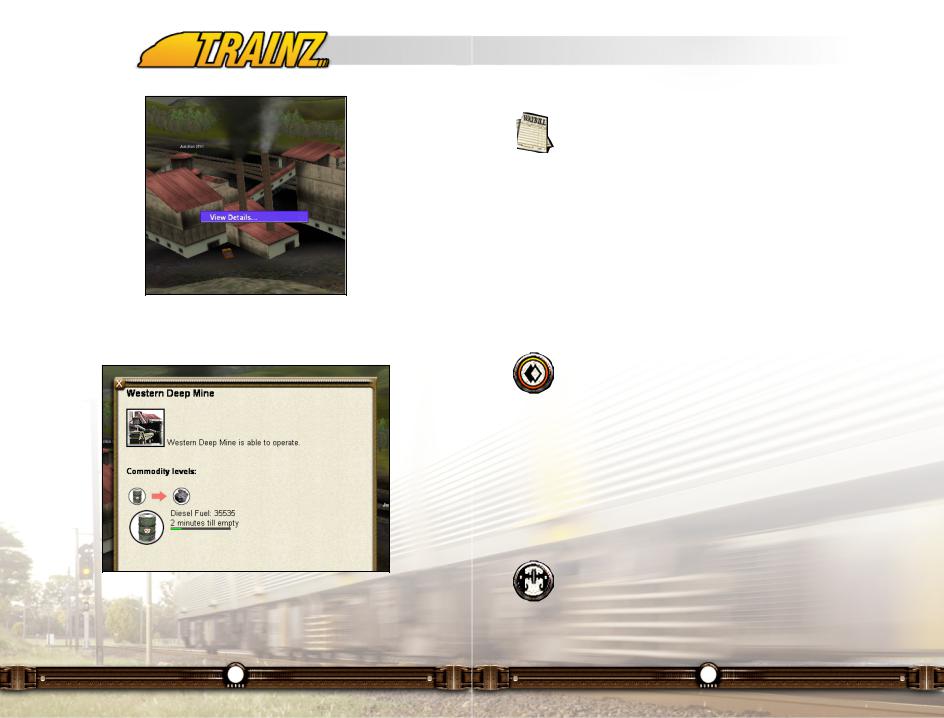
See the section 10.4.4 of this manual for more detailed information on how to configure commodity levels in an industry.
Close the window by Clicking LMB on the "X" in the top left corner.
9.11Waybills – Who Needs What
Click LMB on the Waybill icon to bring up a list of industries that have created waybills showing that they require certain products for delivery. Click LMB on each industry icon in the list to show what
quantities of products are required.
Waybills are automatically produced by an industry when that industry reaches a percentage of capacity of a particular commodity. Once the full amount required by the Waybill has been delivered, the Waybill is deleted from your list (although another one may well have appeared in its place).
The tutorial sessions "Tutorial 2 - Waybills" (British Midlands route) and "Tutorial 5 - Drivers" (Highland Valley Industries route) introduce you to how Waybills can be used to keep you informed.
9.12Commodities
You can allocate which commodities are carried by a particular item of rolling stock. Click on the Commodities icon on the lower right of the screen to bring up the Commodities Menu. Click on an
appropriate icon and then click on an item of rolling stock. The icon shows that the rolling stock is now limited to carrying only that type of Commodity. To stop any commodity being loaded or unloaded, use the "Stop" icon. To allow the default load only, use the "Default" icon. You can only assign commodities to vehicles built for carrying that type of commodity.
Play through "Tutorial 6 - Commodities" on the "City and Country USA" route for an introduction to working with commodities.
9.13Decoupling
To activate decouple mode, click on the Decouple icon (or press the "Ctrl-D" key), then move your cursor over the couplers between train cars until you see a red decouple icon. When the red decouple icon
appears, click LMB to decouple the consist at this point. When you have successfully performed the decouple operation, the red coupler icon “opens” and a message is displayed on the screen. The act of decoupling creates a
40 |
41 |
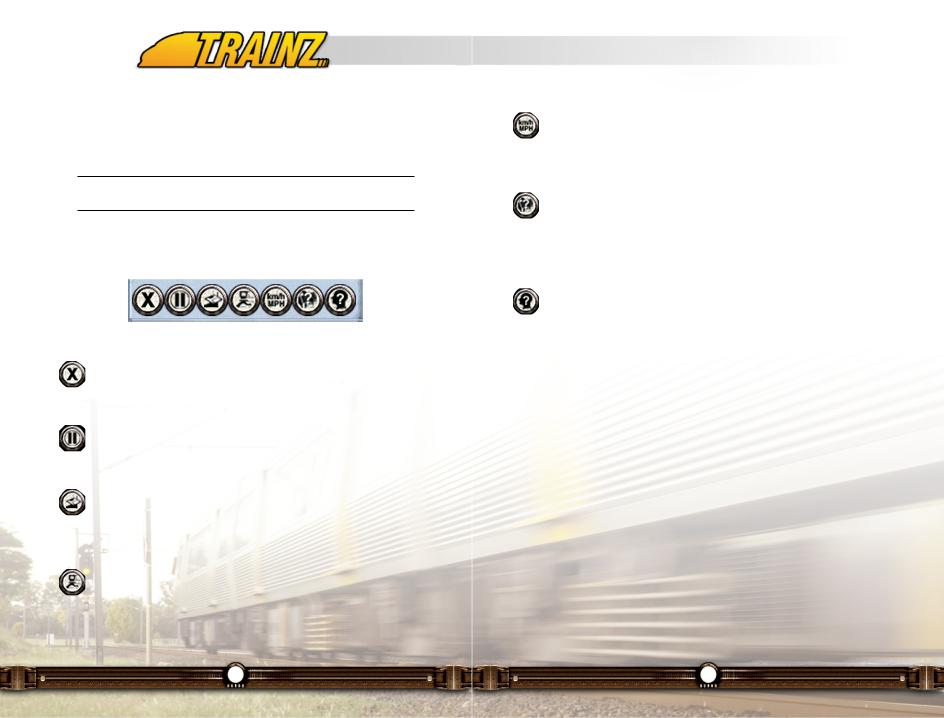
new consist and your camera remains focused on the same car or loco as before the decoupling operation. To re-couple, ensure that you are operating at speeds below 5mph (8kph). Experiment with different camera positions to make this task easier.
Tip: In DCC mode you must apply the handbrake ("A") before uncoupling to avoid runaway wagons.
9.14Other Functions
At the top left, there is a group of icons that let you carry out other general functions.
Exit (Esc)
Quit the current session back to the Driver Main Menu or Surveyor screen with the option to save the session before exiting.
Pause (P)
Suspend the current session so that you can answer that important phone call or finally stop for a lunch or dinner break.
Save (Ctrl-S)
Lets you Save your progress including where each train is located and the state of each industry. To reload a Saved Session, choose the
"Saved Session" option from the Driver Main Menu screen.
Performance Settings (Ctrl-T)
This is where you can tweak the graphics slider settings to improve the visual quality of your game. See section 7.3 for more details of what
these settings do.
Imperial/Metric (G)
Toggles the settings from Imperial to Metric or vice versa. This will affect parts of Trainz that involve the display of measurement/speed
information such as the Time & Speed HUD Panel.
Find (Ctrl-F)
Lets you locate a particular item such as a junction, station, loco or interactive industry. Selecting the item will move the camera position to that position on the route. See section 11.13.4 for further details of the Find
functionality.
On Screen Help (Ctrl-H)
Toggles the display of on screen icons such as turnout direction markers.
More details of what these icons do can be found in section 12.6 of this manual.
9.15Mastering Operations
The tutorials mentioned in section 9.2.1 show you how simple it is to get started in Driver mode to operate the railroads that come with TRS2006 or those built by yourself or others. For an expanded explanation of the capabilities of Driver Mode, see Chapter 12 - Engineer’s Guide of this manual.
42 |
43 |
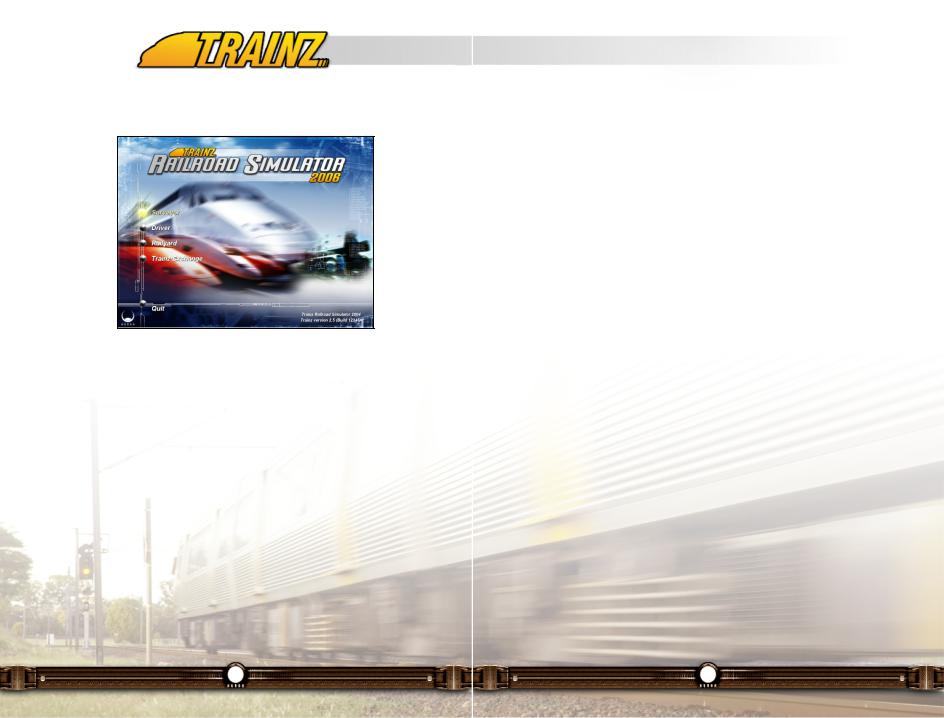
10 - Surveyor
10.1Introduction
Welcome to Surveyor, the user-friendly World/Route/Layout builder. Surveyor is a tool where you can jump in straight away and have some fun, but also may take some time and patience to master.
Using Surveyor and your imagination you can create terrain, paint it with textures and then populate it with trees, shrubs, buildings, roads, power lines, animals and people. You can create lakes and rivers, change the weather conditions and even change the color of the sunset.
There is the ability to create your railroad, with track, stations, signals, maintenance facilities, turntables and the plethora of trackside infrastructure that combine together to form a working railroad. You can edit the default Routes or start out from scratch making your own creation. You can also download a huge number of Routes created by others from the Trainz Download Station and modify them to suit your tastes.
In Surveyor you also place the locomotives, rolling stock and drivers that are the "actors" on the stage you create for each of your Driving Sessions.
10.2What’s new in Surveyor Mode in TRS2006?
If you are familiar with earlier versions of the Trainz product, we thought we'd give you a quick list of significant differences in the Surveyor module between TRS2006 and the earlier versions:
•Backdrop scenery items
•Animated turnouts
•More than 50 rules
•Custom content search filter
10.3Flexibility and Framerates
Welcome to the Surveyor world builder tool. Surveyor is a tool that needs some experimentation. It is free-form, open-ended software at its best and our users will probably find ways to utilize it beyond anything we originally envisioned.
With this freedom also comes a dilemma. The Surveyor tool has no constraints on the amount and variety of objects that can be placed in your 3D world. Therein lies the issue, the more types of objects, the slower will be the performance of the Driver component of the software. You can minimize these frame rate effects by keeping the variety and number of objects minimal. Their effect on frame rate is in that order, first variety and then quantity. Keep this in mind when putting your world together and you will have a more pleasant driving experience.
With Surveyor you can create terrain, populate it with trees, shrubs, buildings, roads, vehicles, aircraft, ships, power lines, animals and people. Then of course there is the ability to create your railroad, with track, stations, signals, maintenance facilities, turntables and the plethora of trackside infrastructure that combine together to form a working railroad.
Let's not forget the new working industries that give your railroad purpose and the locomotives and rolling stock that are the actors on the stage you create.
We will start with a step-by-step guide to creating a very basic operational
44 |
45 |
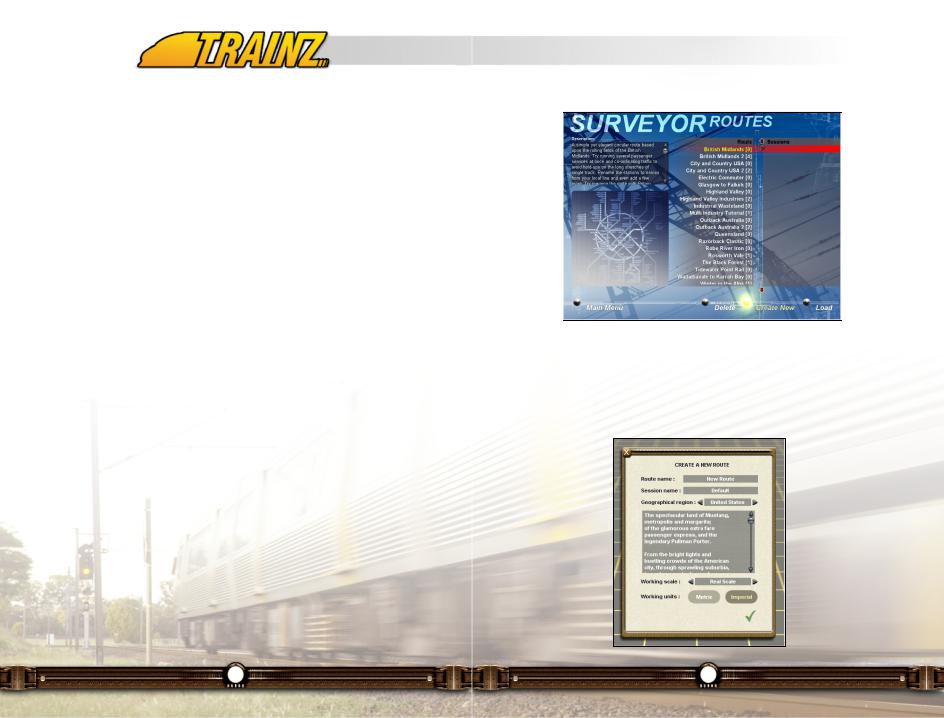
route. This will demonstrate the main aspects of Surveyor. The sections that follow that provide a detailed description of each of the tools available to you within Surveyor.
Surveyor is a powerful editor that lets you create your own worlds, landscapes and railroads. Create hills, mountains, valleys and streams, populate the world with all types of scenery objects, and of course lay your track, signals, turnouts, consists and even program the operation of the Route.
You can edit the default Routes or those created by others. Or you can start out from scratch making your own creation. You can also download a huge number of Routes created by others just like yourself from the TRS2006 Download Station and modify them to suit your tastes.
The following tutorial provides you with just the basics to help you get started in making your first TRS2006 route.
10.4My First Railroad
In this section we will be building a single baseboard map with a hill in the center and a simple oval of track connecting a power station to its source of fuel, a coal mine. If you feel you are ready you may wish to skip this section and move to the more detailed instructions beginning with Chapter 11 - Surveyor in Depth.
Begin by selecting the Surveyor option on the TRS2006 Main Menu. The following screen appears.
d

The details of this screen will be discussed later in this document.
For the purpose of this tutorial, Click LMB on Create New. We are going to create our route from scratch. A new window will pop up as follows, asking you for some map details.
46 |
47 |
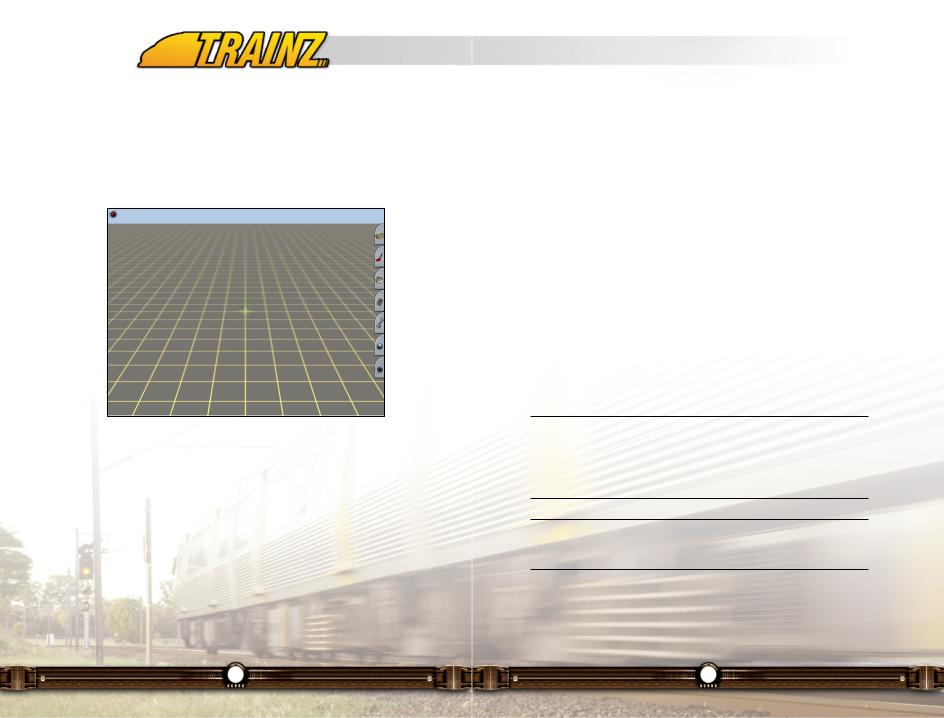
For now click in the "Route Name:" field and type "My First Layout" and leave the rest of the fields as they are. Click LMB on the tick (checkmark) to be taken to the Surveyor editor.
The next thing you notice is the baseboard marked out with a grid and with a 3D compass in the center of the screen.
This compass is always centered on your screen. If you get close enough to the compass, you will see that the compass is marked with the East, West, North and South compass directions to assist you in aligning your route geographically.
10.4.1Compass Movement and Camera Skills
The first task to learn in Surveyor is how to move around the baseboard and control your camera. Mastering these two basic skills will make your time in Surveyor much more enjoyable.
In the middle of the baseboard is your Surveyor Compass. There is also a small white arrow on the screen. The arrow is your default cursor, which you can control by moving your mouse. Move your cursor to the right of the Compass and Click RMB. The compass will move to that position and the
screen is re-centered on the compass.
Next, Click RMB+H and move your mouse slowly towards the edge of the screen. You will notice the compass following the cursor as you move around the terrain. Learn to control the speed of movement by moving the compass close to or away from the center of the screen. Keep practicing these movements until you can successfully control the direction and speed you wish to move.
Use the arrow keys on your keyboard to rotate the camera around the compass. The left and right arrows rotate the camera. The up and down arrows change the elevation of the camera. Press the Page Up and Page Down keys to zoom in and out or you can use the mouse-wheel on your mouse if you have one.
When you zoom in close, notice how the compass has the four directions N, S, E and W. This is helpful to stay orientated in your TRS2006 world, positioning your railroad properly with respect to the rising and setting sun. Yes on a clear day, the sun does rise and set in your TRS2006 World!!!
Tip: Spend some time using a combination of the mouse and keyboard commands that control the viewing pane in Surveyor. This is an important skill to develop and some time invested now will reward you with effortless flitting around the map as you construct your railroad empire.
Tip: The Undo/Redo buttons are found on the top menu panel. Use them if you want to retrace your steps backwards and forwards respectively.
48 |
49 |
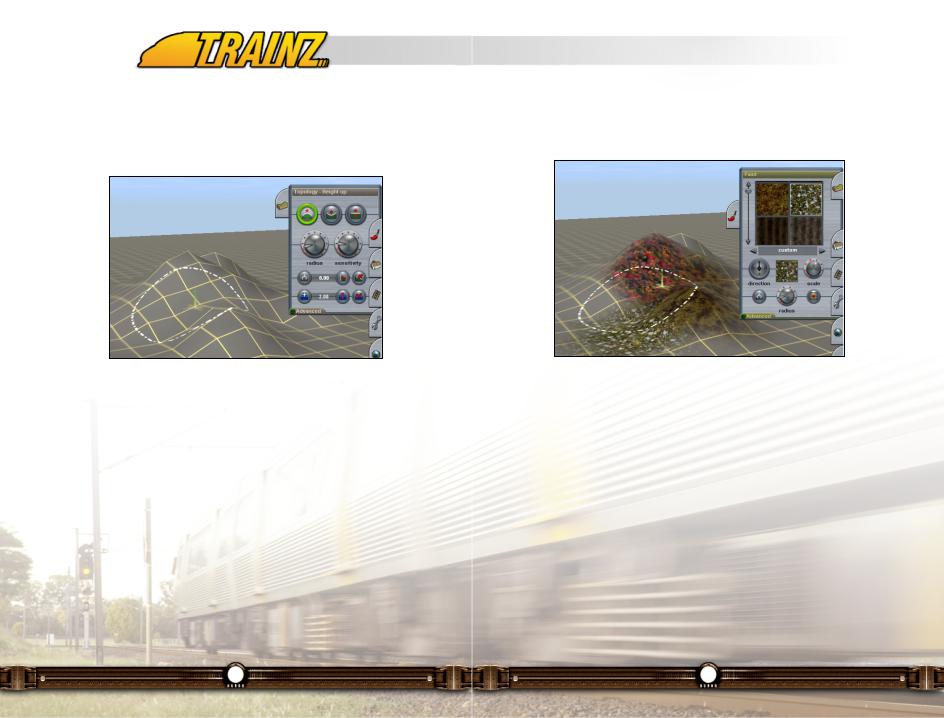
10.4.2Make a Mountain
Okay let's start by clicking on the Topology Tab. It's the Tab at the top of a Tab Panel on the far right of the screen. Out from the right of the screen flies a menu panel.
For now select the Height Up tool (each tool has a label which pops up when you move the cursor over the tool) with a Click LMB. Then Click LMB+H on the Radius tool and drag it around until its dial is in the 12 o'clock position. Do the same with the Sensitivity dial. When you move the mouse cursor back onto the Surveyor map it has changed to a dotted circle.
Place the circle around the center of your square baseboard and Click LMB+H. the longer you hold the LMB the higher and bigger the hill becomes. Move the mouse around while LMB+H and you can create various peaks and ridges as shown above. Don't go overboard here as you'll want to leave some room for trackwork…not that mountain ranges have ever stopped a track laying engineer.
10.4.3Ground Texturing
When you are happy with your hill Click LMB on the Painting Tab from the tabs at the right of the screen (it's the second one down).
The Topology menu disappears to be replaced by the painting menu. Scroll down the texture palette until you find a texture you like. Again select the radius of the texture effect by Click LMB+H on the Radius dial and moving it until you are happy with the size of the painting circle. Then Click LMB to apply the texture to the terrain.
Select a couple of different textures and play with blending them (overlapping), rotating them using the Direction tool or the "[" or "]" keys. Select a Texture with a directional pattern in it. Click LMB+H on a spot on your route and then press the "[" or "]" keys repeatedly to see how this works.
Change the size of the pattern (the scale of the texture) by using the Scale tool. Change the size of the area covered (the white circle) using the Radius tool or the "+" or "-" keys.
You can get some very artistic and realistic effects. Keep playing until you are happy with the result.
50 |
51 |
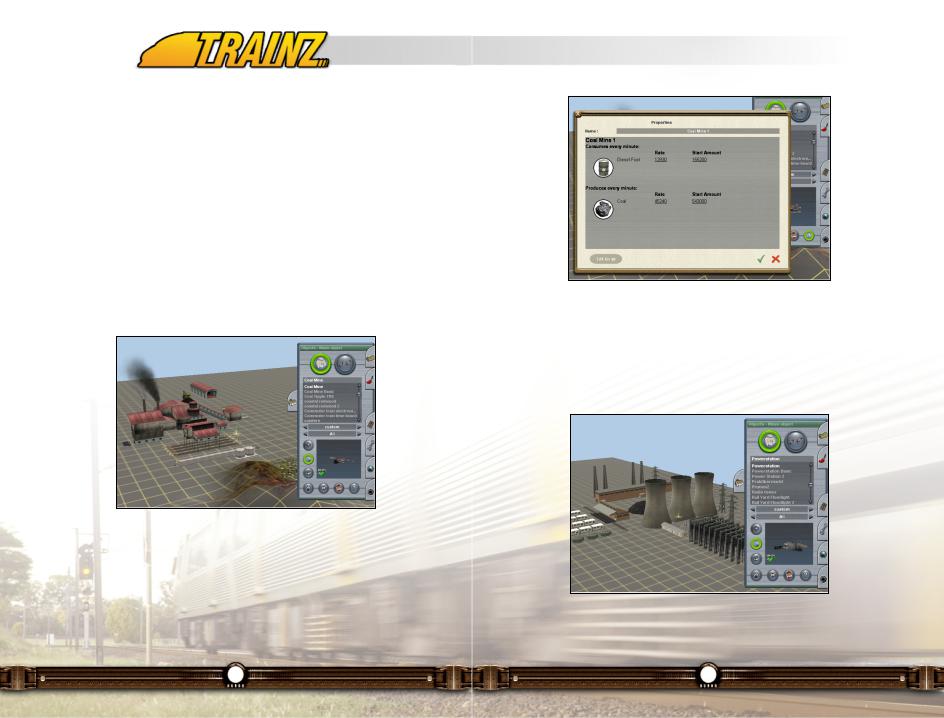
Now make sure that you are back to having only the mountain, nicely textured in the center of the route. Use the Undo function to undo any extra texturing that you may have been playing with.
10.4.4Coal for Industry
Now let's place a couple of linked industries. First select the Object tab from the tab panel and select the Coal Mine object.
You will find this under Object Type "Industrial". Make sure you are in the Add Object mode by Click LMB on the Add Object button. Then move the view to one side of your board and Click LMB on the map to place the Coal Mine. You can move and rotate the object by Click LMB on the Move and Rotate buttons respectively. To do this, Click LMB+H on the mine in the view window and then move the mouse accordingly. Position the Coal Mine as shown below.
Next set the coal mine's properties by first Clicking LMB on the Edit Properties button (highlighted in bright green in the screen above) and then Click LMB on the Coal Mine. First let's give it a name. Type in "Lignite Coal Co" in the name box. We will set the rate of coal production to 200. Do this by Clicking LMB on the underlined default production rate and entering 200 in the pop up window. Similarly we will change the diesel consumption to a value of 0. Set the Start Amount for each to 0. Click LMB on the tick and we have defined our active Coal Mine.
10.4.5Give me Power
Next we'll set up a coal-fired power station. As we did for the Coal Mine, select the Power Station. It is in the same list as you found the Coal Mine. Place it on the other side of the baseboard (and the mountain). Move and rotate the power station as required to line up the tracks as shown below. Set its properties which in this case is only to name it to "Kinetic Power Co".
52 |
53 |
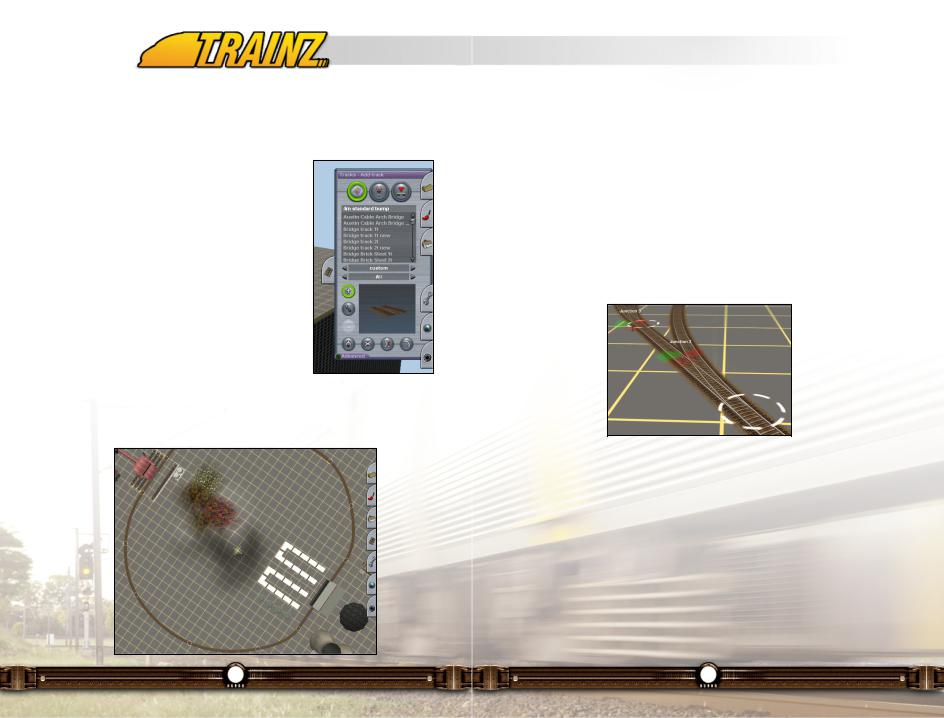
10.4.6Lay your Tracks
Now we will link up these two industries via a simple oval loop. The goal is to link up the Coal Mine's loading track to the oval and run it around to the Power Station's coal unloading track. Go to the tab panel and select the Track tab.
Choose the type of single track you want to use. Make sure you are in the Add Track mode (the large green button above is lit when you are in that mode). Start laying track by Click LMB on the board where you want to start the track. You will notice a white circle associated with the track wherever you Click LMB on the board. These are called Spline Control Points. We will manipulate these points later to move the track either horizontally or vertically. These Spline Control Points are also attachment points for bridges, tunnels and other spline enabled objects.
The track is drawn between consecutive spline points. Click LMB on the map to add another spline point and the track smoothes itself out between the two points, a very useful feature. However, there are limits!
Attach one end of the track to one of the coal mine loading tracks (there are four) and the other end to the power station track by Clicking LMB one new end point onto the track as shown in the screen shot above. Do the same on the other side so you have a continuous loop. You can also smooth out your track laying efforts by Click LMB the Move mode button in the track menu and then Click LMB+H on any of the track spline points in the view window. Move the mouse to move the spline points and watch as the track follows. Play with this until you are happy with your loop of track.
Just for fun, let’s add a siding. Click LMB on the Add Track Button and click on your existing loop of track. A new spline point appears and you can now Click LMB again, away from the loop and create a siding.
10.4.7Locomotives, Rolling Stock and Trains
We will now place a train of a locomotive and rolling stock on the track. Select the Trains Tab from the Tab Panel. Then scroll down and select a locomotive from the list of available items. Let's choose a ATSF F7A unit. Once it is selected, Click LMB on any spot on the track you laid in the view screen to place the locomotive. The locomotive will appear on the track with arrows above it defining the ends of the consist and which direction will be forward when you drive it.
54 |
55 |
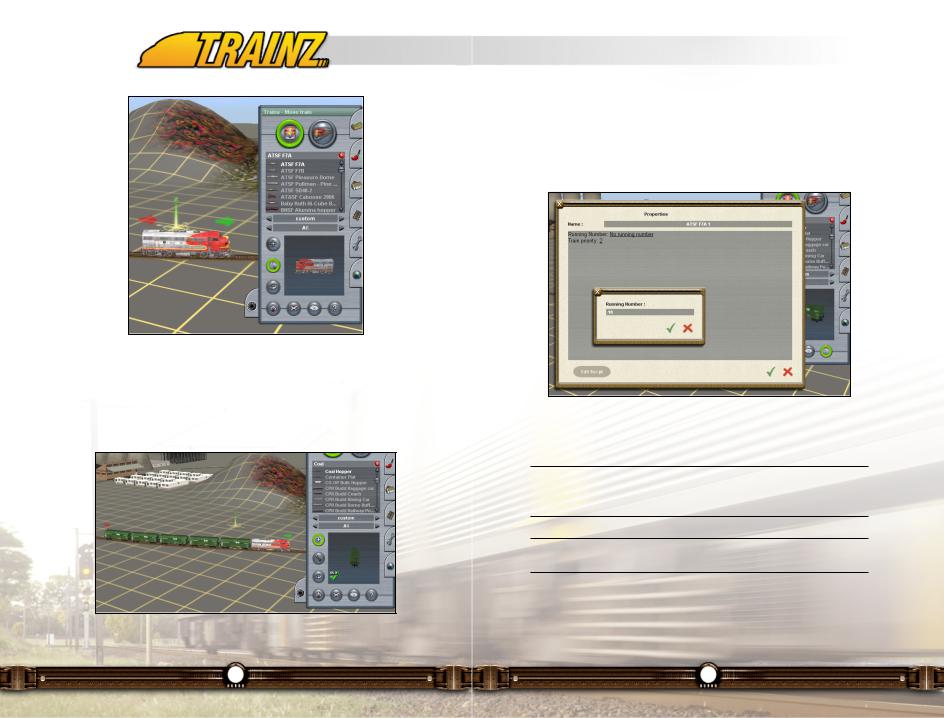
Next, select the green coal car (called "coal hopper") from your list of engines and rolling stock. Click LMB on the placed locomotive towards the back of the loco and the coal car will appear behind the locomotive. Keep on Click LMB on the last car in the consist to add more coal cars. Stop when you have added 5 coal cars. You will now see a consist on the track.
Let's name our consist by first Clicking LMB on the Properties button (lighted
in green below at the bottom of the tab). Then Click LMB on the locomotive in the view panel. In the pop-up window type, click on the existing name (ATSF F7A 2 in the screen shot below) and type in "Coal Train" to replace it. Give it a running number of 10 by clicking on the underlined "running number" text and typing "10".
10.4.8Assign a Driver
Our next challenge is to assign a driver to the Consist.
Tip: This is optional as you may wish to drive your own trains in your route. But using Drivers adds a whole new dimension to TRS2006 so we will do that next.
Tip: If you save a session without entering any Rules, a default set of Rules is applied for you.
Move the mouse to the top of the screen to bring down the top menu and Click LMB on the word "Surveyor" in the menu to pull down the Surveyor menu. We will explain all of these options later in this document.
56 |
57 |
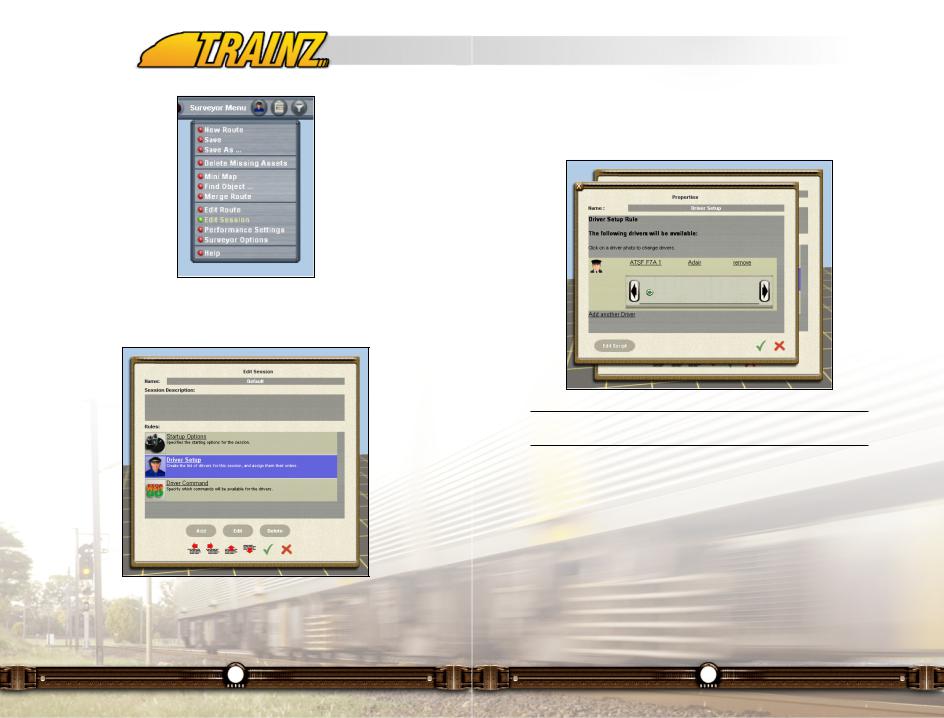
For now, Click LMB on the Edit Session option. A pop-up window named "Edit Session" appears.
This window is where the rules that define a session’s behavior are added and configured. As this is a new empty session, three default rules are already included and configured so some minimal functionality is already available and the session can be run.
Click LMB on 2nd rule named "Driver Set Up Rule" such that it is highlighted in blue. Then Click LMB on the Edit button to open the properties window for that rule.
Tip: In any of these windows if you decide not to go through with the change, click on the red "X" to cancel your selections.
The Driver Setup Rule is responsible for assigning driver characters to trains for the session. It will automatically try to find every loco and have a driver character assigned to it already. In this case, you will see how a driver character has been assigned to the ATSF F7A locomotive.
As this is a simple session without the need for complex driver arrangements, the automatic assignment done by the rule is sufficient, but for the sake of configuring a rule, click on the driver character icon to bring up a list of drivers.
58 |
59 |
